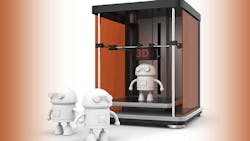Get Out in Front of the 3-D Printing Revolution
In the three decades since the invention of 3-D printing, we've seen countless disruptive technologies. Some—like smart phones—stuck around and continue to shape the way we live and communicate. Others—like pagers—shook things up for a while but quickly slipped into oblivion as more compelling innovations edged them out.
3-D printing, however, is a different kind of disruption. It's a slow burner, but it's one that promises to revolutionize how we design and manufacture products. It's hard to tell exactly what role 3-D printing eventually will take in manufacturing. But we're confident that it's going to make an impact. That's why manufactures should start exploring the potential now if they haven't already.
The question around 3-D printing has always been about the most practical applications. So far, we're not seeing a 3-D printer in every home as some had predicted. Users have shown this technology is better suited for industrial purposes like prototyping and product development.
Every day, more and more companies are discovering the benefits. And we now see adopters taking the technology in a new direction. They're using 3-D printing for industrial manufacturing, and what's more, this use has incredible growth potential.
3-D printing has reached a level of sophistication that should demand the attention of smart manufacturers. At the very least, these companies should carefully consider what it will mean for their businesses.
Taking a Closer Look
Last year, my company (UPS) invested in a startup called CloudDDM, which hosts a 3-D printer facility—about 100 printers so far—at our global air hub in Louisville, Ky. Customers upload their designs to the 3-D facility and then select quantity, material type, color and print priority. CloudDDM can produce those parts late into the evening and pass them to us for next-day delivery. A lot of people and companies are already using this service.
Perhaps it seems counterintuitive that a shipping company would partner with a company that uses technology that someday might lessen demand for its core services. Isn't it harmful to our business to support a technology that allows customers to print goods closer to the point of consumption?
In a way, it is. But we do it for good reasons. For one thing, we believe 3-D printing is a strong complement to the supply chain and logistics services we currently offer. For example, a customer might opt to 3-D print parts rather than invest in costly storage for inventory. That may not work for all products, but it will for some. And if we can bring that solution to customers alongside our traditional offerings, we'll open new doors for them and stimulate loyalty in the process.
Second, we believe 3-D printing will continue to advance and will become even more mainstream than it is today. We believe it's wise to know as much as possible about the technologies that threaten to disrupt our business model. We want to work with disruptive technologies and manage the impact they have on us and use them to our advantage.
For us, 3-D printing offers risk as well as reward. It's going to affect us whether we're ready or not. I often tell folks that in business you can be the bug or you can be the windshield. We would rather be the windshield.
Early Adopters See Benefits
So who is using 3-D printing?
Early adopters include high-tech companies, and they continue to lead the way. For example, smartphone manufacturers are using the technology to 3-D print upgradeable hardware and internal parts. Medical device companies also have embraced 3-D printing.
There are more than 10 million 3-D-printed hearing aids in circulation worldwide. Other industries that are using 3-D printing include automotive and aerospace.
Companies that use 3-D printing see faster prototype production and a wider range of design options. That means they can create products with new properties and capabilities. They can customize small production runs and reduce waste. They also can pay less to produce parts in small batches.
Still, like any new or evolving technology, there are obstacles to broad-based adoption of 3-D printing. The printers are slow, and materials are limited. And some potential users believe 3-D printing is still too expensive.
What's more, companies that outsource 3-D printing to third parties need assurances that their intellectual property is safe and that the quality of printed parts and products will be top notch.
But the industry is advancing fast, and these barriers eventually will vanish.
Looking to the Future
The future of 3-D printing has yet to be written, and the outlook is far from certain. But we know 3-D printing is a supply chain disruptor. And we know it's a manufacturing disruptor.
Realistically, we don't see it taking over a big piece of either business. But even small slivers of these businesses amount to big opportunity and big money.
I liken public perception of this technology to the rise of the Internet in the mid-1990s. People can see that 3-D printing is a big deal. They may even understand that it's here to stay. But they may not know what to make of it just yet.
Technology is not disruptive simply because it's new or different. It's disruptive because it allows people to do things better than they could before. Whenever you can do that, you're creating opportunity, which, in turn, creates jobs.
My advice to manufacturers is this: Explore 3-D printing and its applications for your business. Embrace the disruption now. You'll definitely want to be on the winning side of this revolution.
Alan Amling oversees marketing efforts for UPS's global logistics and distribution services. He moved into this role after serving as head of the New Product Development Concepts Team, overseeing the development of some of UPS's largest product and marketing initiatives.
